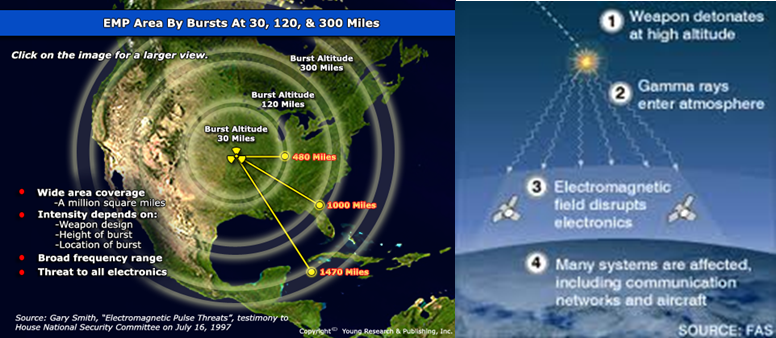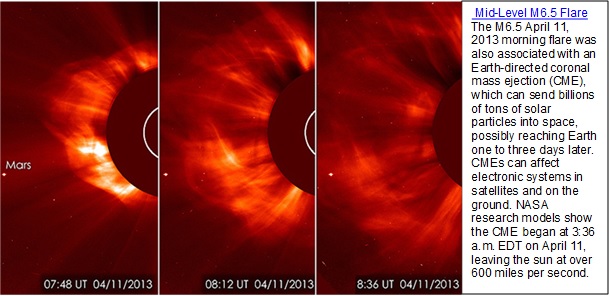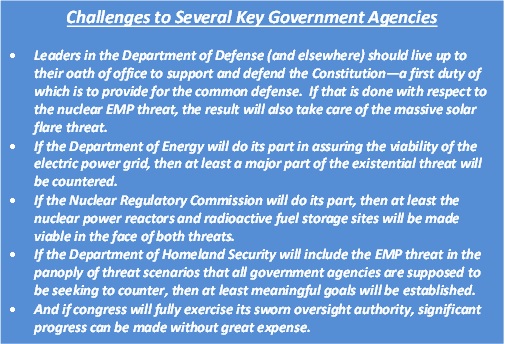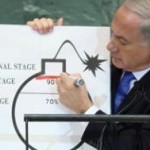High Frontier . . Building Truly Effective Defenses . . Reagan’s Vision Lives!
E-Mail Message 130415
April 15, 2013—A Dynamic Duo: Red Line Dawning?
Everyone is focused on North Korea and whatever its young leader, Kim Jong Un, may be doing to build up his credibility with his military, or to coerce South Korea into softening its policies, or to win direct talks and aid from Washington. At least the last possibility seems to be playing out—as suggested by Secretary of State John Kerry’s recent trip and his efforts to get China’s help in derailing North Korea—wonder what China’s help will cost?
Indeed, how much will Uncle Sam pay during this appeal to “multilateral” diplomacy? (In what currency and to what end?) It seems likely to be another “triumph of hope over experience” in a cyclic process that for over 20-years has failed to stop North Korea’s development of nuclear weapons and ballistic missile delivery systems of all ranges?
Public confidence no doubt was eroded by last week’s public display of the intelligence community’s confusion on North Korea’s status in adapting its nuclear weapon for carriage on a ballistic missile (or as a satellite payload, as discussed in our April 8 email report ). And it is a little disconcerting when our leaders say we are prepared for all contingencies—when some seem to be ignored, as discussed in our April 11 Flash Message.
While focusing on North Korea, we should remember that Iran has long collaborated with North Korea—and will likely exploit whatever lessons North Korea learns. So, we should pay close attention to Iran and its approach to Prime Minister Binyamin Netanyahu’s “Red Line” for Iran’s threat to the “Little Satan” Israel—which also has significant implications for America, “the Great Satan.”
 Victor Davis Hanson’s excellent April 12 article, “The Sum of Duel Fears,” discusses some consequences of Iran getting a nuclear weapon. A notable observation is that: “We should assume that the Iranian theocracy, like the seven-decade-old Kim dynasty in North Korea, periodically would sound lunatic: threatening its neighbors and promising a firestorm in the region if not eventually in the United States and Europe as well.” And his bottom line is “If North Korea has been a danger, then a bigger, richer and undeterred nuclear Iran would be a nightmare.”
Victor Davis Hanson’s excellent April 12 article, “The Sum of Duel Fears,” discusses some consequences of Iran getting a nuclear weapon. A notable observation is that: “We should assume that the Iranian theocracy, like the seven-decade-old Kim dynasty in North Korea, periodically would sound lunatic: threatening its neighbors and promising a firestorm in the region if not eventually in the United States and Europe as well.” And his bottom line is “If North Korea has been a danger, then a bigger, richer and undeterred nuclear Iran would be a nightmare.”
We Need to Counter Attacks from the South.
Our April 8 email report discussed how North Korea’s satellite launches demonstratred an inherent capability to launch an Electromagnetic Pulse (EMP) attack on the continental United Strates over the South Pole to attack us from the south. They have already launched 220 pound satellites in orbits that pass over the United States at 300-350 miles altitude, just the right altitude for an EMP weapon burst that could cover the entire continental United States, as illustrated below.
 Iran also has launched satellites, so they could plausible also attack America from the south in this same way, they just would have to launch on a different azimuth—once they obtain a nuclear weapon that complies with similar payload constraints.
Iran also has launched satellites, so they could plausible also attack America from the south in this same way, they just would have to launch on a different azimuth—once they obtain a nuclear weapon that complies with similar payload constraints.
Our Aegis BMD ships may be inherently capable of shooting down satellites which might be carrying nuclear warheads as discussed above. We have 17 such ships in the Pacific today, and will have a similar number in the Atlantic. A key requirement will be to provide needed timely tracking information to the Aegis fire control system—which can be done if it hasn’t been already. A significant problem will be how to know whether a nuclear weapon is being carried by a satellite launched by Iran or North Korea—and for appropriate authorities to authorize such an intercept in time.
A similar problem exists for the ground-based interceptors in Alaska and California—and perhaps in the future somewhere on the East Coast. The defense interceptors are inherently capable of intercepting satellites—if they have the needed reach and can be cued into the battlespace with appropriate tracking information. But as they are currently configured, they are focused on defeating North Korean and Iranian attacks  from the over the North Pole, not the South Pole.
from the over the North Pole, not the South Pole.
In addition, there is another way to attack America from the south—from vessels in the Gulf of Mexico. We discussed this particular attack scenario in our October 26, 2012 open letter to U.S. citizens who live around the Gulf, noting our complete vulnerability to such an attack, in which a ballistic missile is launched from a vessel in the Gulf, with its nuclear warhead detonated over the center of our country.
We also informed them that the U.S. Navy has a way to defend them against this attack—by deploying at military bases around the Gulf the same Aegis Ashore ballistic missile defense (BMD) sites we are building to defend our European allies against Iran’s ballistic missiles. But no such program is included in the President’s budget.
It should be noted that we observed over a decade ago Iranian tests of ballistic missiles launched from vessels in the Caspian Sea with signatures that strongly suggest these were dry runs for conducting an EMP attack, as reported to Congress by its EMP Commission.
Other Actions to Respond to the Threat?
It is interesting to note that in 2006, as North Korea was preparing to test a long-range ballistic missile that they thought might reach the United States, now Deputy Secretary of Defense Ashton B. Carter and past Secretary of Defense William J. Perry co-authored a Washington Post OpEd entitled “If Necessary Strike and Destroy.” In it they argued that, “If North Korea persists in its launch preparations, the United States should immediately make clear its intention to strike and destroy the North Korean Taepodong missile before it can be launched.” They argued that though there was risk in destroying a missile that could attack America, “the risk of continuing inaction in the face of North Korea’s race to threaten this country would be greater.”
Perhaps they were right; and perhaps Deputy Secretary Carter might consider his own advice now that he may have a vote on stopping Iran before it gains a nuclear-armed intercontinental ballistic missile. Iran has followed the same pattern of buster and diplomacy as North Korea, and our response has so far been to choose “hope over experience” with similar results. No doubt our Israeli friends would vote with him.
Progress Reports.
As emphasized in earlier reports, it seems clear that grass roots efforts will be needed to impress on the Washington “powers that be” that the folks back home want to be defended against the threats discussed above. In the coming weeks, we will focus on informing Americans around the Gulf of Mexico of the threat from the south against which we are totally defenseless—and what can be done about it. This includes deploying Aegis Ashore sites at military bases around the Gulf—like those we are deploying in Europe to defend our allies against Iranian missiles. We will work initially in Mississippi and Florida.
While we will focus on the ballistic missile threat, we will emphasize the need to harden the electric power grid, at a minimum, to assure we can survive a massive solar geomagnetic storm—missile defenses are useless against this natural threat, which will occur. As discussed in our December 30, 2012 report, the only question is when? Below is a flare that occurred a few days ago—looks like Mars took the main blow and we dodged a bullet, this time.
 Such hardening is a necessary but not sufficient condition to assure society’s survival following a nuclear event, but it is an important first step. Other damaging effects from a natural major EMP event or a nuclear EMP event are more easily repaired than would be living without the transformers essential to the electric power grid.
Such hardening is a necessary but not sufficient condition to assure society’s survival following a nuclear event, but it is an important first step. Other damaging effects from a natural major EMP event or a nuclear EMP event are more easily repaired than would be living without the transformers essential to the electric power grid.
A big part of the problem in dealing with the existential EMP threat is that no one seems to be in charge. As discussed in our March 11 email report, suggested action items were as follows.
 Notably, in response to a question from Senator Lisa Murkowski (R-AK), Energy Secretary Nominee Ernest Moniz indicated in his April 9 confirmation hearing that he wanted to learn more about the EMP threat and to assure the “robustness and resilience” of the electric power grid in dealing with natural and unnatural threats. See 4:39 into the linked video to see the exchange. Hopefully, if confirmed, Dr. Moniz will follow up, because the Energy Department can make an important contribution to assuring the electric power grid will be functional following an EMP attack.
Notably, in response to a question from Senator Lisa Murkowski (R-AK), Energy Secretary Nominee Ernest Moniz indicated in his April 9 confirmation hearing that he wanted to learn more about the EMP threat and to assure the “robustness and resilience” of the electric power grid in dealing with natural and unnatural threats. See 4:39 into the linked video to see the exchange. Hopefully, if confirmed, Dr. Moniz will follow up, because the Energy Department can make an important contribution to assuring the electric power grid will be functional following an EMP attack.
Finally, we again applaud Maine Representative, Andrea Boland (D-Sanford), for her legislative efforts to require all new transmission lines of the to-be-installed $1.4 billion Maine Power Reliability Program be protected against major solar storm geomagnetic effects. We will discuss her LD 131, which has been voted out of committee, once we have the legislation and have studied it, but it is possibly setting an important precedent for other states to follow. For an in-depth analysis of her efforts and related background concerns, see Dr. Peter Vincent Pry’s comprehensive Family Security Matters article, “Maine’s Battle to Save America.”
And what should you do?
Join us at High Frontier in seeking to alert the public to the existential threats posed by both manmade and natural EMP events—and what can be done about these threats.
We can use your help in spreading the word to grass roots and local authorities to press the powers that be to provide for the common defense as they are sworn to do. Will you do your part?
Begin by passing this message to your friends and suggest they visit our webpage, www.highfrontier.org for more information. Also, please encourage your sphere of influence to sign up for our weekly e-newsletter!
Please click here to read Past Weekly Udpates!
Please click here to read past Flash Messages!
Please help High Frontier continue this important and timely work!
 Be sure to follow us on our Social Sites!
Be sure to follow us on our Social Sites!
If you found this letter via our Social Sites, and you would like to subscirbe, click below!




